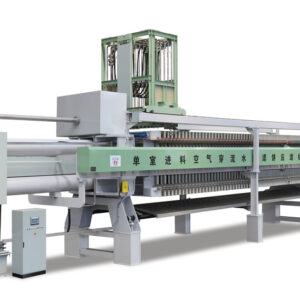A Belt Filter Press is a type of wastewater treatment equipment that uses a series of belts and rollers to dewater sludge and separate solids from liquids. It is commonly used in municipal and industrial wastewater treatment plants to treat sewage sludge, industrial sludge, and other types of sludge.
The Belt Filter Press operates by applying pressure to the sludge through a series of rollers and belts, which squeeze out the water and separate the solids from the liquids. The solids are then collected on the belts and removed from the equipment, while the liquid is collected and discharged for further treatment or disposal.
Some benefits of using a Belt Filter Press for sludge dewatering include:
High efficiency: The Belt Filter Press can achieve high levels of dewatering, with dry solids content of up to 25-35%.
Easy operation: The Belt Filter Press is relatively easy to operate, with a simple design that requires minimal operator intervention.
Low energy consumption: The Belt Filter Press operates at low pressures and does not require a lot of energy to operate, Belt Filter Press making it a cost-effective option for sludge dewatering.
Space-saving: The Belt Filter Press has a compact design, which allows it to be installed in small spaces, making it a popular choice for wastewater treatment plants with limited space.
Environmentally friendly: The Belt Filter Press can reduce the volume of sludge by up to 80-90%, which reduces the amount of sludge that needs to be disposed of, making it an environmentally friendly option.
Overall, the Belt Filter Press is a reliable and efficient option for sludge dewatering in wastewater treatment plants, offering high efficiency, low energy consumption, easy operation, and a space-saving design.
How does the Belt Filter Press compare to other sludge dewatering methods?
The Belt Filter Press is one of several sludge dewatering methods available for wastewater treatment. Here’s a comparison of Belt Filter Press with other common sludge dewatering methods:
Centrifuge: Centrifuges use centrifugal force to separate solids from liquids. Compared to the Belt Filter Press, centrifuges are faster and more efficient, but they are also more expensive and require more maintenance.
Screw press: Screw presses use a slowly rotating screw to compress the sludge and separate the solids from the liquids. Compared to the Belt Filter Press, screw presses are smaller, require less space, and are easier to operate, but they are also less efficient and have a higher cost per unit of dry solids.
Plate and frame filter press: Plate and frame filter presses use a series of plates and frames to separate solids from liquids. Compared to the Belt Filter Press, plate and frame filter presses have a higher capital cost, require more maintenance, and are less efficient, but they are also more versatile and can handle a wider range of sludge types.
Drying beds: Drying beds are a low-tech, low-cost option for sludge dewatering that use gravity drainage to remove water from the sludge. Compared to the Belt Filter Press, drying beds are less efficient, require more space, and are more labor-intensive, but they are also a low-cost option for small wastewater treatment plants.
Overall, the choice of sludge dewatering method depends on the specific needs of the wastewater treatment plant, including the type and volume of sludge, available space, budget, and other factors. The Belt Filter Press is a reliable and efficient option for sludge dewatering, offering high efficiency, low energy consumption, easy operation, and a space-saving design.
